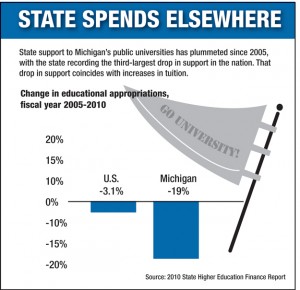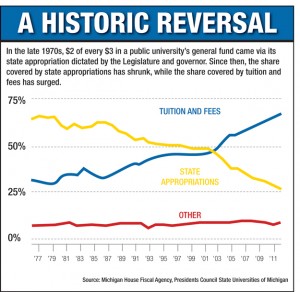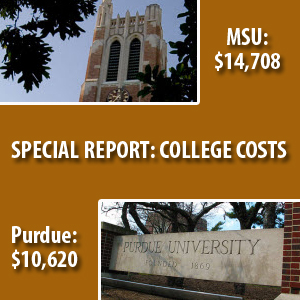'College tax' burdens students, state
Caroline Robinson and Barbara Twist are cousins who share far more than bloodlines. They are both seniors in college; each attends one of the top public universities in the nation.
The similarities stop, however, when the tuition bills arrive. Barbara is paying twice as much for her education at the University of Michigan as Caroline must pay at the University of North Carolina.
Michigan families pay more to send their children to state universities than families in almost any other state, according to a Bridge Magazine analysis. Not coincidentally, Michigan also gives less money to its public universities than almost any other state.
“It’s ridiculous,” said Twist, 22, who will graduate in the spring with about $28,000 in student debt -- compared to $0 debt for her North Carolina cousin. “All of Michigan needs to take an economics class.”
An economics class would call it what it is – a college user tax paid by Michigan families that can add tens of thousands of dollars to the cost of a diploma.
A decades-long decision to skim money from the state’s 15 public universities means Michigan teens face a higher hurdle to attend college and leave campus with more debt than their peers in other states -- both factors that are likely to erode the Michigan’s ability to revitalize a moribund economy.
The price of learning
College costs across the country have doubled in the past decade, according to the Consumer Price Index, partly because of rising health-care and retirement costs of university employees. But the difference in cost between public higher education in Michigan and other states can be traced to one thing: Budget decisions made in the State Capitol. As state support drops, more of the cost of college is shifted to students and their families -- a 21st century "college tax."
To measure that impact, Bridge split Michigan’s state universities into groups of academically similar institutions across the country (See box at right), and calculated the true price (tuition, fees and on-campus housing minus scholarships and grants) of a year in college.
In many cases, the cost differential was sobering.
 The University of Michigan in Ann Arbor, for example, had a net cost of $16,888 in 2008-09, the latest year available, compared to the $12,738 for the median of its peer group. That means three years at U-M costs as much as four years at many other high-caliber research universities.
The University of Michigan in Ann Arbor, for example, had a net cost of $16,888 in 2008-09, the latest year available, compared to the $12,738 for the median of its peer group. That means three years at U-M costs as much as four years at many other high-caliber research universities.
U-M’s net cost was sixth highest among 73 universities in a peer group of public “very high research” universities, ranging from Arizona State to Virginia Tech.
"Lost appropriations" was the catalyst for much of U-M's tuition increases in recent years, said Phil Hanlon, U-M provost and executive vice president for academic affairs. The Ann Arbor campus has lost $174 million in inflation-adjusted dollars in the past decade -- a trend that Hanlon calls "unsustainable."
U-M created a 16-page report detailing cuts and efficiencies put in place to save money in the past decade.
"It's tough to get that message out about the work we've done to cut costs" when tuition continues to rise, said Hanlon, who also noted that state dollars now make up only 7 percent of U-M's academic budget.
That has led U-M to the highest student price among a more select peer group of the top 12 public universities in the country, as ranked by U.S. News and World Report. This group includes the University of Virginia, UCLA, the University of California-Berkeley and the University of North Carolina.
 UNC has a stellar reputation like Michigan, with identical ACT scores of incoming students. But support from the state of North Carolina is the equivalent of $19,460 per student like Caroline Robinson at Chapel Hill; in Ann Arbor, students like Barbara Twist get the equivalent of $7,119 in state support.
UNC has a stellar reputation like Michigan, with identical ACT scores of incoming students. But support from the state of North Carolina is the equivalent of $19,460 per student like Caroline Robinson at Chapel Hill; in Ann Arbor, students like Barbara Twist get the equivalent of $7,119 in state support.
The result: On average, from the time freshmen walk into U-M dorms until they graduate four years later, they’ll spend $33,860 more than a Tar Heel native would at the University of North Carolina for the same diploma.
High costs across the state
Up the road in East Lansing students at Michigan State University also encounter high bills. MSU's average net cost of $14,708 was the 15th highest among 73 schools in its peer group.
By comparison, Purdue University, a land grant school with high academic standards similar to MSU, has an average net price of $10,620. That means Michigan students will pay $16,000 more for an engineering degree at MSU than an Indiana resident will at Purdue, just because they live north of the 42nd parallel.
The story is the same at other campuses. Central Michigan's University's net price of $14,183 was second-highest in its peer group of 30 universities; Western Michigan University and Michigan Tech both had net prices more than 20 percent higher than the median for their peer groups.
"The cost has gone up as a direct result of lower funding (from the state)," said CMU President George Ross. "We've gone from state universities to state-assisted universities to state-located universities."
Only Wayne State, U-M Dearborn and U-M Flint had prices below the average for their peer groups.
Public good vs. private benefit
Michigan public universities cost more because they are subsidized less by the state than public universities in most states.
Michigan has slashed about 20 percent of the dollars (adjusted for inflation) for four-year colleges between 2005 and 2010; only Rhode Island and New Mexico cut more.
Since then, the Legislature and Gov. Rick Snyder whacked another 15 percent from the higher education budget for 2011-12. Michigan now ranks in the bottom 10 in the nation in per-capita spending on higher education, doling out $159 per state resident to its public universities.
In the early 1970s, three-quarters of university funding came from the state and one quarter from tuition. Today, those numbers are reversed.Michigan’s public universities now get a greater share of their funding from tuition than public universities do in 44 other states.
“Michigan has been disinvesting in education far before the recession and these catastrophic cuts,” said MSU President Lou Anna Simon. “The priorities were not higher education, when others states were investing in education.”
The poster child for that trend could be GrandValleyStateUniversity, where, over the course of four years, students pay an average of $23,000 more than the median for the school’s peer group.
Among the 161 public universities in GVSU’s peer group, Grand Valley has the sixth-highest net cost -- and the third-lowest percentage of state support.
“Grand Valley has essentially been privatized,” said Matt McLogan, vice president for university relations at GVSU*. “It’s publicly owned, but is no longer publicly supported in any way that people would recognize."
 MSU ranks 61st out of 69 peer schools in the ratio of tuition support to state support. U-M is 66th of 69.
MSU ranks 61st out of 69 peer schools in the ratio of tuition support to state support. U-M is 66th of 69.
“Making college even more expensive is terrible public policy in a state that doesn’t send enough of its high school grads to college now,” said McLogan.
“Elected officials have decided that Michigan will have one of the lowest levels of public support for higher education in the country,” said James Duderstadt, former U-M president and chairman of the Millennium Project, a research center focused on the ways technology affects society. “They decided that college isn’t a public good, but a private benefit.”
That argument, according to Duderstadt, goes something like this: Those earning a bachelor’s degree earn $1 million more than high school graduates on average over their lifetimes, so why should taxpayers subsidize their education?
Michigan once answered that question the way most other states still do: Everyone benefits from more educated residents, explained McLogan.
“My generation and my parents’ generation, who built the universities, thought it was better for the economy to have as many college grads as possible,” he said. “They have better jobs, make more money, fewer are on public assistance and in prison. But today the attitude of the Legislature is ‘It’s up to you, buddy.’”
These cost shifts have not hurt enrollment -- enrollment is up at most of the schools. Applications are at record levels. That could mean Michigan families still consider the state’s public schools to be a good value. Or, it could mean that they have nowhere else to turn.
Michigan public universities are still cheaper than most private schools; other states’ public universities that are such a bargain for their residents are pricey for out-of-state students.
U-M student Twist cut right to the basic market economics:
“When there’s a cut in (state) funding, the universities pass the burden to the students. Here’s 45,000 students who can pay more tuition. And if they don’t want to pay more tuition, there are 45,000 more waiting to get in.”
"The demand is high not because it is a value, but because the market is telling students that it's still a better idea to go to college and pay the tuition than not," said Jane Wellman, executive director of the Delta Project on Postsecondary Education Costs in Washington, D.C. "Everybody's got to have some sort of post-secondary education."
But rising costs at public universities are "hurting the students having to pay the higher tuitions and taking on debt levels that are unsustainable," she said. "Tuitions are going up and (university) budgets are being cut at the same time; students are paying for more and actually getting less; the money is not showing up in the classroom; the quality of what's being offered is probably at a breaking point."
A modest proposal
The cumulative result of years of decisions at the State Capitol is a huge divide between Michigan and the rest of America. Just to reach the middle of the pack in per-capita spending on universities, Michigan would need to increase higher education funding by 56 percent; to reach the top 10, the state would need to almost double the $1.26 billion it now spends on universities.
That could mean more taxes (reaching the top 10 in per-capita funding would mean an extra $154 per Michigan resident). It could mean reordering priorities (The $1.7 billion business tax cut passed in 2011 far exceeds the current higher education budget).
"At the end of the day, we still have one of the finest sets of universities in the country," said CMU's Ross. "It's a jewel. And we have to protect the jewel."
Protecting higher education is cheaper than you might think. Consider this: Cutting $1,000 from the annual cost of attending Michigan’s public universities for every full-time, in-state student, would cost each state resident $23, according to the House Fiscal Agency’s Kyle Jen.
That’s 44 cents a week.
Double that – with every resident paying roughly the price of a candy bar more weekly toward higher education – and students would graduate with a bachelor’s degree with $8,000 less debt than they do now.
Duderstadt isn’t hopeful. Other states are beginning to cut back on higher education funding. California’s vaunted state universities suffered a massive cut this year. Florida public universities have raised tuition by 15 percent four years in a row. At the University of North Carolina, Caroline Robinson took part in tuition strikes to protest proposed increases in student costs.
Duderstadt believes public universities will be indistinguishable from private universities by the time today’s college students have children enrolled at MSU.
College cousins Twist and Robinson don't have to imagine the economic angst that will cause. “The way we’ve talked about college has always been different because Barbara has always had to deal with debt,” said Robinson. “That debt could affect the way she looks in the job market, whether she rents or buys, whether she has a roommate, what kind of car she drives. It changes everything.
“Barbara will be stronger emotionally because of it,’ Robinson said. “But it didn’t have to be this way.”
*Editor's note: Matt McLogan serves on Bridge Magazine's Board of Advisers.
See what new members are saying about why they donated to Bridge Michigan:
- “In order for this information to be accurate and unbiased it must be underwritten by its readers, not by special interests.” - Larry S.
- “Not many other media sources report on the topics Bridge does.” - Susan B.
- “Your journalism is outstanding and rare these days.” - Mark S.
If you want to ensure the future of nonpartisan, nonprofit Michigan journalism, please become a member today. You, too, will be asked why you donated and maybe we'll feature your quote next time!

